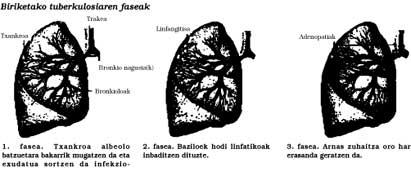TB tuberculosis (TB)
Introduction Introduction Introduction Introduction
Infectious disease is the one that normally has a chronic course. It produces the bacterium Mycobactrium tuberculosis. Also called Koch bacillus, it was discovered by a German doctor of the same name in 1882. The most frequent location of the disease is in the lungs, but it can also affect other organs.
Despite the advances made with the new drugs that the medicine has in hand, the infection is still very widespread. Age, profession or profession and the social situation have much to do with the evolution of this disease.
More frequent in the first years of life, especially during lactation, and also between 15-30 years. Cases that occur from the age of 55 years in recent years have increased considerably.

A few years ago (before chemotherapy, above all) the first contact with the germ (primary tuberculosis) was at 6-8 years, but at present it has displaced at 16-18 years in developed countries.
Symptoms of symptoms and symptoms
The manifestations of tuberculosis are divided into two large groups, those corresponding to primary tuberculosis and post-primary tuberculosis.
The first, created by the first contact with the germ, usually does not show significant symptoms, although in some cases there appears fever and weakness or fall.
Post-primary tuberculosis, on the other hand, caused by the second contamination or the worsening of the primary, can happen without symptoms. Symptoms are usually inaccurate: cough, general discomfort, loss of appetite (not too big, but light), point of inflammation and sweat at night. If the disease has spread to other organs (outside the lung and which organ it affects), diarrhea, urinary discomfort, bone pain, etc. They can appear.
Treatment and prevention
Rest, adequate feeding, and certain antibiotics for months.
In addition to improving living conditions, contagious patients (who expel bacilli through the mouth in the cough and snail) should be isolated. The control and preventive treatment of people living in the same family nucleus of the patient, and the integration in the cases of greater risk, would be other of the main preventive measures.
Consultation with the doctor
What is the tuberculin test? Why should all family members of tuberculosis perform this test?
It is a method of aid for the diagnosis of tuberculosis. A preparation derived from the bacilli of tuberculosis is only a cutaneous reaction that occurs after intradermal injection. If the person who is tested has had contact or contact with these bacilli, their immune system responds by causing inflammation or inflammation at the injection point of tuberculine. The results are recorded at 48-72 hours, according to the size of the area that has been hardened around the injection point.
Is it possible to have tuberculosis with negative tuberculin?
Normally, if this test results negative, there is no tuberculosis. But there are situations where this does not happen: for example, when tuberculosis is massive, or when the person is taking immunosuppressive drugs, or because he or she has some disease (sarcoidosis, etc.) Its immune status is very weakened.
Therefore, the fact that the tuberculin test is not positive does not mean that the person does not have tuberculosis. In case of suspicion, other studies should be done to obtain a good diagnosis: X-rays, blood tests, etc.
Is it true that there are still many cases of tuberculosis?
It is true. Before finding TB drugs, this disease was one of the most important in the world. Not only by frequency, but also by gravity, since in most cases it was incurable. Despite the fact that at present the severity is lower, tuberculosis is still very widespread in countries with little health infrastructure and in the population groups that live in unfavorable socio-economic and nutritious situations (especially in Third World countries).
However, in developed countries the disease has not completely disappeared, nor has it been turned around. On the contrary, there is much more than expected. Tuberculosis at the beginning of the century caused about 200 deaths per 100,000 inhabitants per year.
Is tuberculosis a contagious disease? To what extent?
It is true that tuberculosis is contracted by breathing the bacilli that some patients expel with cough. And we must highlight some, since in many cases the bacilli are like “kept” inside the tuberculous focus and are not expelled when coughing, breathing or speaking. Germs can only canporate when the infectious focus opens up to a bronchus. To know if the bacilli are in the karkais, we will have to perform the proper tests that indicate whether or not the patient transmits the infection. If, after repeated analysis, there are no bacilli of tuberculosis in the cell, the affected person is not contagious, so it is subjected to treatment without being isolated.
Is it necessary to treat the tuberculosis patient in a special medical center or is it possible to treat him at home?

The decision will be made by the doctor in view of several factors. There are no general rules. Each case is different. Admission to a hospital or hospital center is mandatory in the following cases: when many proper diagnostic tests are needed, when symptoms are severe, when there are other diseases that can complicate tuberculosis, when a high degree of contamination is observed in the carcaise and when ara-zoak is observed to isolate the patient at home. Even if it is observed that treatment does not produce the expected effects. On the other hand, the need for hospitalization can also be motivated by social reasons, when the patient cannot be properly attended at home or for reasons of consideration that the treatment will not be properly followed.
How long should the treatment be maintained?
Until a few years ago the treatment was extended for 18 months. It has now been shortened a lot, but it still stays between six and nine months. Over time, the patient takes fewer medications than the initial one.
It should not be forgotten, however, that if the tuberculous person leaves treatment (because it is okay and the discomfort has disappeared) there is a great chance that the disease will recover. And, on the other hand, it is totally demonstrated that with proper treatment it is cured safely.
Is there any interference between contraceptives and tuberculosis treatment?
One of the drugs used in the treatment of tuberculosis is rifampicin, an antibiotic that reduces the action of certain drugs by associating them. In the case of anovulatory it is necessary to adapt the doses since otherwise the contraceptive can lose effectiveness and remain pregnant. Interference also occurs with other medications (cortisone, digital, some anticoagulants, etc. ). Therefore, before starting another treatment, it is convenient to tell the doctor that you are taking the rifan pizza.
Can we say that tuberculosis is totally cured today?
Yes. A good medication manages to cure all patients. Therefore, it is important that the treatment is carried out properly, during the necessary time and when necessary. Most patients, including the most advanced cases, are cured in one year. What's more, it's possible for the sick to realize a completely normal life.
After healing the person should it be controlled?
During the two years following the completion of the treatment it is advisable to continue performing some type of control. If during this period nothing strange is observed, since relapse does not appear only in 1% of cases, it is not considered necessary to carry out more controls.
What are the prison analyses and what are they for?
The finding that the bacillus of tuberculosis is found in the snail is a key data for diagnosis. However, the absence of bacilli in karkais does not mean that there is no active tuberculosis infection. When there are other signs that give us the feeling of tuberculosis (either by X-rays, or by the symptoms of the disease), the ideal is to start treatment, after making sure there is no other disease. On the other hand, it is convenient to make the first analyses have negative results and then, if done repeatedly, give positi-bos. Therefore, as a rule, three, four or five analyses are performed.
In the company’s annual medical recognition they tell you “You, as a child, had tuberculosis”, although you don’t remember it.
In childhood it is very common to have some tuberculosis infection of the lungs that has passed unnoticed, since it is cured by itself. But it will leave several marks for life; scars or calcified nodes, etc. And in that scar, with the passage of time the calcium will accumulate. For this reason, the presence of calcified lesion in the conventional radiological study entails an old and cured tubercular lesion, almost in sulfur ruins. In this case, however, other studies (including more x-rays) are usually done to ensure that it is not an active focus of tuberculosis.
What to say about the BCG vaccine?
This vaccine, prepared with the bacillus of Calmette-Guerin (hence its name), does not provide total immunity to the bacillus that produces tuberculosis. Its effect is to stimulate the immune system to fight against bacillus in case of infection. From this point of departure, although it is possible to catch tuberculosis (despite being vaccinated with BCG), in addition to the fact that the disease is milder, its most serious complications such as tuberculosis meningitis are probably avoided. Currently, this vaccine is only applied systematically in countries where tuberculosis is very widespread.
What people or groups should be incorporated?
It is not necessary to include the entire population. On the other hand, one of the discomfort of the vaccine is the positivation of tuberculin after its administration, so this test no longer serves to diagnose the initial infection. The vaccine, therefore, will only be given when the risk of getting sick is high: for example, children in the family of all affected by tuberculosis. Inclusion in some countries is recommended during schooling, but not in others, depending on the incidence of the disease.
Three different antibiotics in the treatment of tuberculosis. Why so much pharmacy?
As is known, the constant taking of antibiotics makes germs in the long term become resistant against them. And he thinks that the treatment of tuberculosis lasts months. The use of a single antibiotic could generate resistance to it. The goal of using three (or four) different antibiotics is, therefore, to avoid resistance to a given drug, as the other drugs will continue to work. In some cases, however, these resistances are created by forcing a change of antibiotic.

- Children in general.
- People with diabetes (2-4 times more and the disease is usually more severe).
- Malnourished people, for example in Third World countries.
- People who do not properly assimilate food because they have been extracted part of the stomach.
- Alcoholics, because they have more tendency to get any infection.
- Older people who live alone and in poor conditions.
- People affected by cancer, since their defenses are weaker and more easily sick.
- Those who have received prolonged treatments of cortisone, which reduces the general organic defenses.
- Silicosis.
- Hospital staff.
(As an orientation model for Individual Health Education) After the study, it has been shown to have pulmonary tuberculosis. It is a contagious disease that is transmitted from one person to another (when speaking, coughing or sneezing, ...), that is, through breathing. Normally to hunt the disease it is necessary to maintain a daily relationship with the sick person. Therefore, someone has infected you, as you have surely been transmitting the disease to the people around you. This does not necessarily mean that everyone is sick, but we must properly analyze them. If the treatment begins, in the next few days it will not contaminate and stop paying special attention and precautions. Tuberculosis is completely cured with adequate treatment, but treatment will be long, 9 months and IN NO CASE eT is necessary. If you have any problems, consult your doctor. It is very important that they always appear in the consultations that have been made to control the disease and treatment. If you have reasons not to attend, you will be notified and changed dates. Once the treatment is finished, it is advisable to continue controlling it for another year.
|
- If the patient is contagious, in addition to avoiding contact with their prisons, they must protect their face with costumes.
- All family members must undergo a tuberculin test.
- If this test is positive, x-rays of the chest will be performed. If lesions suspected of tuberculosis were observed in them, treatment will be performed. If no suspicions are observed on X-rays, a preventive treatment with a single drug (Isominzida) will begin.
- In case this test is negative, it will be performed again 2 months after the interruption of the relationship with the patient. If the second tuberculin has a positive result, treatment will begin (with antibiotics).
- In the case of children, treatment should be performed even if the tuberculin is negative and the x-rays are normal. Some doctors also have this behavior with adults.
Infectious diseases are not a chimera of the past
After finding and using antibiotics, humanity was going to victory in the fight against infectious diseases. Great epidemics could only occur in dark times in which ignorance and poverty dominated. And AIDS?. Well, that's also a matter of drug addicts using dirty syringes. That's what many have wanted to think about. Also the big governments and pharmaceutical companies. In recent decades, less and less research has been done on the clinical aspect of infectious diseases and more and more has been invested in this field. If it's a problem that affects fewer and fewer people who can afford drugs, why spend money?
But the victory has not been so much sought after. The fight against certain infectious diseases has not been so successful and although they have not been given too much attention, the data have been there (see side J. Aguirre's article on tuberculosis). Now that data indicating an increase in tuberculosis has been released in developed countries, we have known that the storm has not been over. And not only that: now we are equipped with greater consistency against antibiotics. For example, malaria is increasingly resistant to chloroquine and there appears to be data indicating that the effectiveness of the mephon that has been marketed a few years ago is decreasing.
Tuberculosis has been, is, and will be one of the greatest killers of the human race. Each year there are 8 million new cases in the world, 91% in developing countries. Every year, 2.9 million people die in the world according to data from the World Health Organization. Mycobacterium tuberculo -sis (causing the disease) is probably the organism that most people kill.

In light of these data, it is surprising that tuberculosis has been labeled with the fire of the disease of the past. The First World Health Meeting at its 1948 meeting gave priority of first order to tuberculosis, while no mention was made at the 1986 meeting. Tuberculosis, however, was there; few cases perhaps in developed countries, but thunder in the third world.
What has this new interest in tuberculosis now motivated, if it is a disease that has always been there? AIDS has to do with, of course, the high incidence of tuberculosis in immunodeficiencies. In the US. There has also been a spectacular increase in the areas of poverty in some cities, due to very poor hygienic conditions. Therefore, in developed countries it is again there, and the blind cannot be done.
A recent report in the United States has confused at least the margins. The report was commissioned by the Institute of Medicine of the National Academy of Sciences of the USA. and affirms that “the risk of infectious diseases has not disappeared and has worsened.”
In addition to the reported tuberculosis and malaria, the report also includes Lyme disease, yellow fever, Rift Valley fever and the Inflamaan virus. In the opinion of the speakers, the growing resistance of microorganisms to drugs is a point to take into account.
For example, tyres are increasingly resistant to penicillin. One of them, Streptococcus neumoniae, responsible for meningitis, peritonitis and various respiratory infections, has also developed resistance to other antibiotics. For example, resistance to erythromycin is between 20% and 28% in France and between 18% and 20% in Japan.
On the other hand, the living habits of people are also very significant in the development of infectious diseases. The mobility of the population is today much higher than in the past, which facilitates the dispersion of germs.
Another aspect that is mentioned in the report is that the remoteness of risk has caused that the stocks of drugs and vaccines have not been properly supplied and that, according to an example they mention, if at present the yellow fever increased in the city of New Orleans, it would have to bring vaccines from Brazil, which is the only country with sufficient stock. Foreseeing this situation, they say that in 90 days 10,000 people could die, so in the conclusions of the report a greater surveillance of stocks is recommended.
Apparently, while they have been considered as diseases of those who could not pay for medications, too much strength has not been exercised to conduct new antibiotics. “With no exception, no new families of antibiotics have been launched in the last 20 years,” says Patrice Courvalin, a researcher at the Pasteur Institute. The launch of new antibiotics is costly. The marketing costs of a new molecule can be around 200 million dollars, so ensuring its profitability is not so easy.
However, in the face of the new situation, medical kit and healthcare administrations around the world are beginning to worry and perhaps see enough reason to take up this issue in the coming years.





